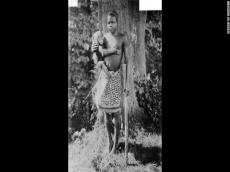|
|
TODAY.AZ / Weird / Interesting
When the Bronx Zoo exhibited a man in an iron cage
04 June 2015 [10:59] - TODAY.AZ

During September of 1906, nearly a quarter of a million New Yorkers flocked to the Bronx Zoo to behold a young African named Ota Benga -- a so-called "pygmy" -- exhibited in an iron monkey house cage.
Protests by a coterie of ministers and a small cadre of elite whites met a wall of resistance as the exhibition of the 103-pound, 4-foot-11 Ota Benga was quietly sanctioned by zoological society officials, the mayor, scientists, the public and many of the nation's newspapers, including The New York Times.
"Bushman Shares a Cage with Bronx Park Apes," trumpeted a New York Times headline on September 9.
"The human being happened to be a Bushman, one of a race that scientists do not rate high in the human scale," said the article. "But to the average nonscientific person in the crowd of sightseers there was something about the display that was unpleasant."

Still, up to 500 people at a time flocked to the monkey house to see the boyish Benga, who often sat on a stool in stupefied silence. The spectacle inspired sensationalized headlines from New York to California and across Europe, and zoo attendance during September doubled over the previous year. On one day alone, 40,000 people visited the zoo, according to figures it released.
Shedding light on racial attitudes
Days after Benga's debut in the monkey house, Times editors were baffled by the ministers' objections, saying: "We do not quite understand all the emotion which others are expressing in the matter."
They added: "Ota Benga, according to our information, is a normal specimen of his race or tribe, with a brain as much developed as are those of its other members. Whether they are held to be illustrations of arrested development, and really closer to the anthropoid apes than the other African savages, or whether they are viewed as the degenerate descendants of ordinary negroes, they are of equal interest to the student of ethnology, and can be studied with profit."
This chapter from our not-so-distant past sheds light on prevalent and pernicious racial attitudes that were embedded in science, academia, government and the media. It both illuminates the racial progress that has been made in a century, but also the residue of attitudes that linger still.
More than a century later, the mass incarceration of young black males, many for low-level drug offenses, and the pervasive police killings of unarmed men have only recently received sustained national attention. And while the televised spectacle of videotaped police shootings has heightened public awareness, many Americans had for decades normalized -- even celebrated -- the criminalization of black men, just as a desensitized public sanctioned the caging of Ota Benga.
It may be easier for Americans to agree that police officers should be equipped with cameras than to address racial views that have stealthily seeped into every segment of society.
Four years before Benga's exhibition, "The Basis of Social Relations: A Study in Ethnic Psychology," published by G.P. Putnam's Sons in New York and London as part of the Webster Collection of Social Anthropology, said that Africans were "midway between the Oran- utang [sic] and the European white." It added: "The African black presents many peculiarities which are termed 'pithecoid' or ape-like."
Callous disregard
Indeed, it was a callous disregard for Benga's humanity that resulted in him being exhibited at the zoo. Benga was first brought to the United States by Samuel Verner, an avowed white supremacist from South Carolina and former African missionary. Two years earlier, he had been commissioned by organizers of the St. Louis World's Fair as a special agent to bring back so-called "pygmies" -- the diminutive forest-dwellers from Central Africa who some scientists at the time inaccurately considered examples of the lowest form of human development.
Before embarking on his mission, Verner secured letters of introduction from U.S. Secretary of State John Hay; William McGee, the president of the American Anthropological Association who oversaw the anthropology department for the fair; and David Francis, the former governor of Missouri and secretary of the Interior who was president of the Louisiana Purchase Exposition, commonly called the St. Louis World's Fair.
Verner also secured the support of Belgian Secretary of State Chevalier Cuvelier, who was, Verner said, "next to the King, the most influential of all the men I should have to deal." At the time, the Congo Free State was the exclusive property of Belgian King Leopold II.
With the imprimatur of U.S. and Belgian officials, an armed and determined Verner went hunting for "pygmies," a term that once referred to monkeys and that some today consider derogatory. Ota Benga and eight other young Congolese males of undetermined ages were exhibited on the St. Louis fairgrounds where they were poked, prodded and otherwise harassed by curious spectators. Two years later, Verner would temporarily turn Benga over to the zoo, where he became a global sensation.
As hundreds crowded around his cage, Benga often sat in sullen silence or mocked the menacing mob. At other times, he distracted himself by shooting his bow and arrow or playing with the orangutan housed in his cage. He would try to evade the howling, heckling mobs with eyes pleading for the keepers to release him from public view. On occasion, he was allowed to amble through the woods under the watchful eye of an attendant, but once detected, he would be pursued by violent mobs and returned to the cage.
While Benga initially seemed resigned to his fate, by the second week he began to resist captivity by either disrobing or threatening to kick, bite or strike attendants as they tried to return him to the cage.

His resistance, and the mounting protests, finally resulted in Benga being released to the care of Rev. James H. Gordon, who ran the Howard Colored Orphan Asylum in Brooklyn's Weeksville section.
For the next 10 years, Benga would, unsuccessfully try to find his way back home while attempting to adjust to American life. He spent the final six years of his life, from 1910 to 1916, living in Lynchburg, Virginia, where he initially was a student in a seminary before securing a job at a tobacco factory and doing odd jobs. There he became a beloved member of the African American community that included Anne Spencer, who would later become an acclaimed poet during the Harlem Renaissance.
Yet Benga's tragic story (spoiler alert) came to an even sadder end. Apparently suffering from depression, he shot himself in the heart with a revolver and died.
Resonance of racism
The biases that resulted in Benga's exhibition have morphed into attitudes that scholars say operate subconsciously.
Recent studies have shown whites remain deeply mistrustful of black men. The study "Race and Punishment" by the Sentencing Project noted the widespread and deep-seated tendencies among whites to link blacks with criminality. Video simulated shooter studies have found nonblack participants far more likely to shoot unarmed black targets. These attitudes can have fatal consequences.
A recent ACLU report found that in Maryland, at least 75 blacks died in encounters with police between 2010 and 2014. Nearly half were unarmed.
While blacks comprise 69% of those killed by police, they make up 29% of Maryland's population. Even in incidents caught on camera, from the beating of Rodney King in Los Angeles to the chokehold killing of Eric Garner, officers typically elude punishment.
In the case of Eric Garner, 90% of blacks and just 47% of whites polled by Pew believed the grand jury erred in failing to prosecute. Even wider racial disparities were found in the Trayvon Martin and Michael Brown killings. In those cases, 82% of blacks and just 33% of whites believe race was a factor in the Ferguson and Garner grand jury decisions.
While politicians on both sides of the aisle finally concede that criminal reform is needed, the deeply rooted attitudes that allowed society to demonize and cage black males and to sanction overzealous policing still warrant reflection.
Even if Republicans and Democrats somehow act to shelve policies that have resulted in the African American male prison population tripling between 1980 and 1999, how do we address the mindset that allowed a war on drugs to become a war on black males -- when they are no more likely than their white counterparts to abuse drugs?
More than 100 years after blatant bias resulted in the traumatic caging of a human being in a zoo, it behooves us to ponder the resonance of ideas firmly planted in the American mind.
URL: http://www.today.az/news/interesting/141184.html
 Print version
Print version
Connect with us. Get latest news and updates.
See Also
- 19 February 2025 [22:20]
Visa and Mastercard can return to Russia, but with restrictions - 05 February 2025 [19:41]
Japan plans to negotiate with Trump to increase LNG imports from United States - 23 January 2025 [23:20]
Dubai once again named cleanest city in the world - 06 December 2024 [22:20]
Are scented candles harmful to health? - 23 November 2024 [14:11]
Magnitude 4.5 earthquake hits Azerbaijan's Lachin - 20 November 2024 [23:30]
Launch vehicle with prototype of Starship made its sixth test flight - 27 October 2024 [09:00]
Fuel prices expected to rise in Sweden - 24 October 2024 [19:14]
Turkiye strikes terror targets in Iraq and Syria - 23 October 2024 [23:46]
Kazakhstan supplied almost entire volume of oil planned for 2024 to Germany in 9 months - 23 October 2024 [22:17]
Taiwan reported passage of Chinese Navy aircraft carrier near island
Most Popular
 Alone in field is not warrior: time has come for military component of OTG
Alone in field is not warrior: time has come for military component of OTG
 Azerbaijan and Kazakhstan are taking region's geopolitics into their own hands
Azerbaijan and Kazakhstan are taking region's geopolitics into their own hands
 Berlin pulls envoy from Tbilisi amid growing tensions over anti-EU rhetoric
Berlin pulls envoy from Tbilisi amid growing tensions over anti-EU rhetoric
 Azerbaijan’s green energy shift redraws map from Central Asia to Europe
Azerbaijan’s green energy shift redraws map from Central Asia to Europe
 Feasibility study for Central Asia–Azerbaijan Green Energy Corridor to begin in November
Feasibility study for Central Asia–Azerbaijan Green Energy Corridor to begin in November
 China alleges US stole classified data from National Time Center
China alleges US stole classified data from National Time Center
 Paraguay seeks greater influence in divided MERCOSUR as trade with the EU gains traction
Paraguay seeks greater influence in divided MERCOSUR as trade with the EU gains traction
